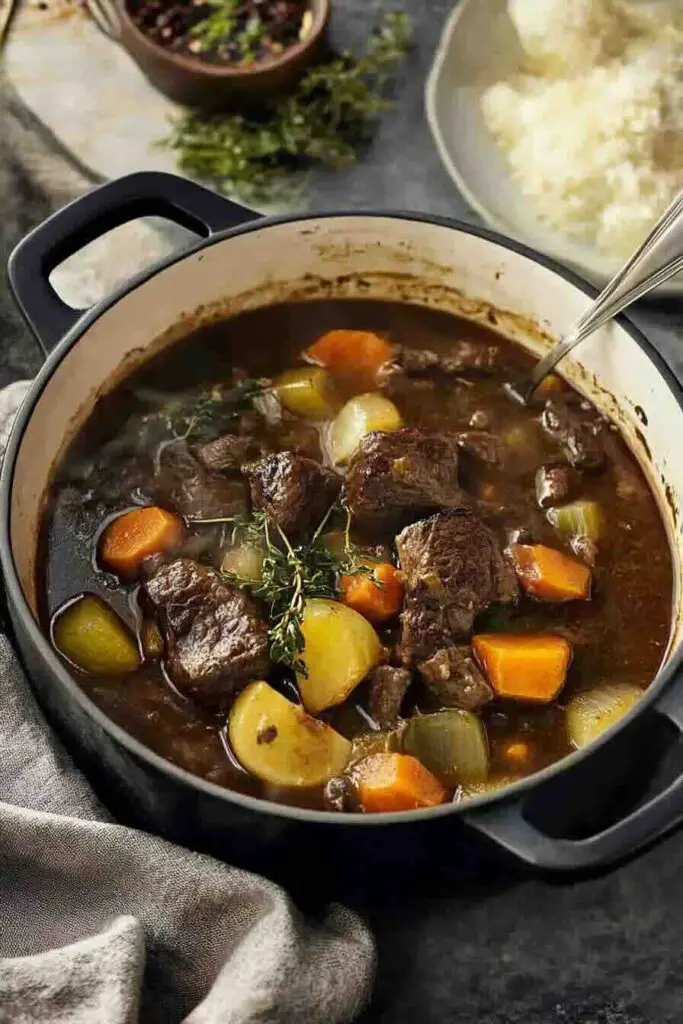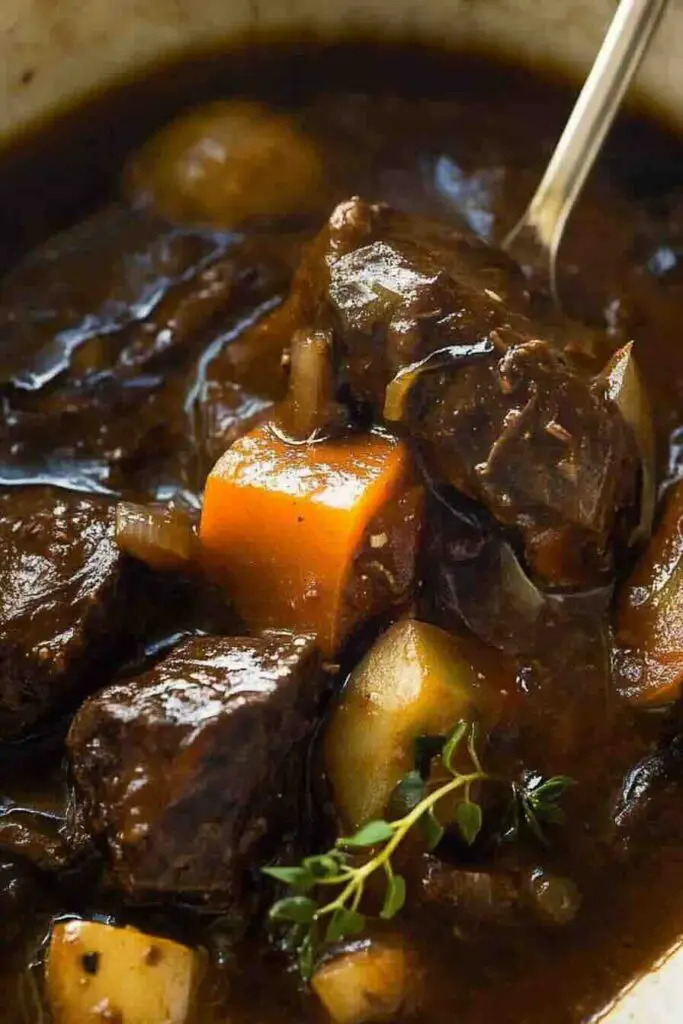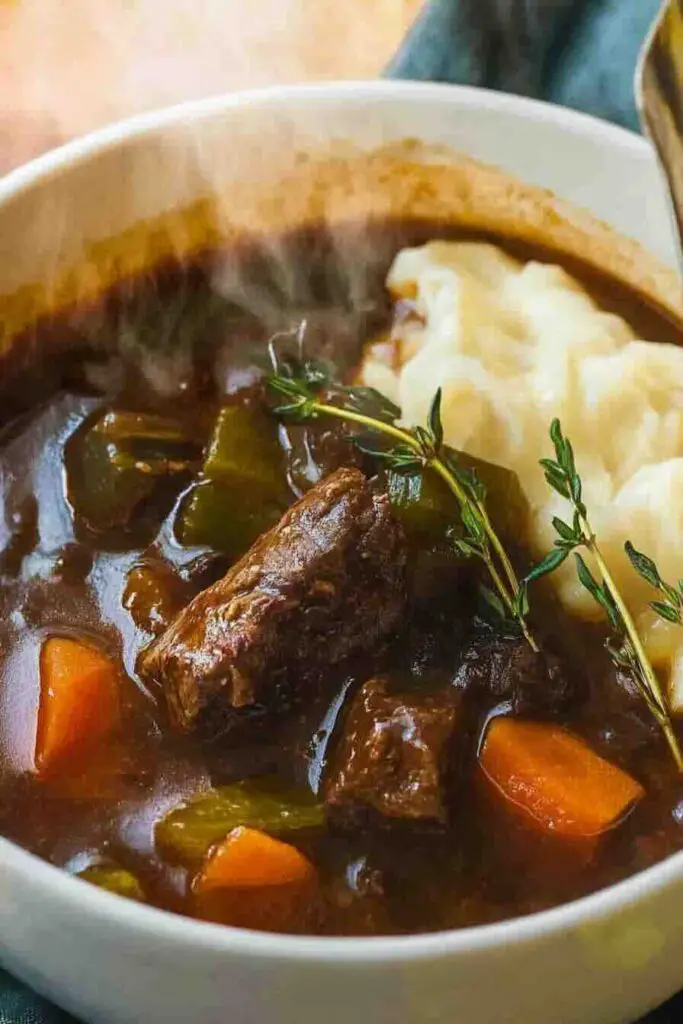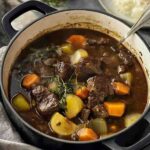Introduction
Let’s be real—there’s nothing quite like a steaming bowl of beef stew to make you feel all warm and cozy inside. That slow-cooked, melt-in-your-mouth beef, the rich, velvety sauce, and all those tender veggies soaking up the goodness? Absolute magic. And the best part? It only gets better the next day.
Beef stew isn’t just a meal; it’s a hug in a bowl. It’s the kind of dish that has stood the test of time, popping up in kitchens across the world in different shapes and flavors. No matter where you’re from, chances are there’s a version of this dish that brings back memories.
But what actually makes a beef stew go from just “good” to “so good you wanna lick the bowl”? That’s exactly what we’re about to break down.

Reasons You’ll Love This Recipe
Oh, you need convincing? Say no more!
- Easy to Make – No fancy techniques, just simple, classic cooking that works every single time.
- Rich, Deep Flavor – A little patience goes a long way! Slow cooking unlocks flavors like nothing else.
- Versatile Cooking Methods – Whether you’re using a stovetop, oven, slow cooker, or pressure cooker, this stew plays nice with all.
- Make-Ahead Friendly – Honestly, it tastes even better the next day. Stew for breakfast? Not judging.
- Customizable – Got dietary needs? No worries. You can tweak it without sacrificing that signature beefy goodness.
What Makes a Good Beef Stew?
A great beef stew is all about balance. You want that deep umami punch, tender chunks of beef, perfectly cooked veggies, and a sauce that’s thick enough to coat a spoon but not so heavy that it feels like glue. Here’s how to nail it:
Choosing the Right Cut of Beef
Not all beef is created equal when it comes to stew. You want something that gets better the longer it cooks—aka collagen-rich cuts that break down into juicy, flavorful perfection. Best choices?
- Chuck roast – The gold standard. It’s got that perfect balance of fat and connective tissue.
- Brisket – Leaner, but packed with flavor. Just be patient—it needs time.
- Short ribs – More indulgent, extra rich, totally worth it.
Layering Flavors
This is where you take your stew from “meh” to mouthwatering. Each step adds another layer of complexity:
- Searing the beef – Browning it first locks in flavor and creates those irresistible caramelized bits (aka the fond).
- Deglazing the pan – Wine, broth, or even a splash of vinegar helps lift up all those delicious browned bits.
- Slow simmering – Low heat, patience, and time let everything meld together beautifully.
Getting the Perfect Sauce Consistency
A great stew shouldn’t be soupy, but it also shouldn’t be so thick that it feels heavy. The trick?
- Use flour or cornstarch to thicken—but don’t go overboard.
- Simmer uncovered at the end to reduce and intensify the sauce.
- Balance the flavors with a little acidity (think tomatoes or wine) to cut through the richness.
Vegetable Selection
Some veggies are made for stew, others… not so much. Here’s what works best:
- Carrots & potatoes – Classic for a reason. They soak up all the flavors.
- Celery & onions – Essential for building that aromatic base.
- Parsnips & turnips – Great swaps if you want a slightly different flavor.
Low and Slow Cooking
This one’s non-negotiable. The longer your stew simmers, the better it gets. Think 2-3 hours minimum for stovetop or oven cooking, or let it go all day in a slow cooker.
The Cultural Significance of Beef Stew
Beef stew isn’t just comfort food—it’s history in a pot. Every culture has its own version, and they’re all amazing.
- French Boeuf Bourguignon – Red wine, pearl onions, and a little butter make this version extra fancy.
- Irish Guinness Stew – Deep, malty flavor from stout beer takes this to another level.
- Japanese Nikujaga – A lighter, slightly sweet soy-based take with thinly sliced beef.
- Jamaican Brown Stew – Packed with Caribbean spices and slow-cooked to perfection.
No matter where you go, beef stew tells a story of tradition, resourcefulness, and resilience.
The History of Beef Stew
Stews have been around for literally thousands of years. Ancient civilizations cooked meat in clay pots over open fires, medieval kitchens combined meats and root vegetables in big cauldrons, and immigrants brought their own takes to different parts of the world. From hearty European versions to spice-laden Asian adaptations, stew has always been a dish of adaptability and survival.

Ingredients Breakdown
The Essentials
- Beef chuck – Tender, juicy, and perfect for long cooking.
- Onions, garlic, carrots, celery – The unbeatable aromatic base.
- Potatoes – Give body and heartiness.
- Beef broth – The backbone of the stew.
Flavor Boosters
- Red wine – Deepens the flavor (optional, but amazing).
- Tomato paste – Adds richness and a little acidity.
- Worcestershire sauce – Umami bomb!
- Bay leaves & thyme – Classic herbs that round everything out.
Thickening Agents
- Flour or cornstarch – Helps create that luscious sauce.
How to Make the Best Beef Stew
Making the perfect beef stew isn’t just about tossing everything into a pot and hoping for the best. No, no, no—this dish deserves a little extra love and attention. The secret lies in layering flavors, choosing the right ingredients, and being patient enough to let the magic happen. If you follow these steps, you’ll end up with a stew that’s so rich and hearty, it’ll taste like something straight out of a cozy farmhouse kitchen.
Step 1: Choose the Right Cut of Beef
Beef stew is all about slow-cooked tenderness, which means you need a cut that can handle long, gentle cooking. Chuck roast is the best option because it’s marbled with just the right amount of fat, making it tender and juicy when cooked slowly. Other great options include brisket, which has incredible depth of flavor, and short ribs, which add an extra level of richness.
Whatever you do, avoid lean cuts like sirloin or filet. They might be great for quick cooking, but they’ll dry out and become tough in a stew.
Step 2: Brown the Meat for Maximum Flavor
This step is non-negotiable if you want deep, beefy goodness. When you brown your beef properly, you create something called the Maillard reaction—a fancy way of saying that the meat caramelizes and develops a ton of flavor.
Start by patting the beef dry (moisture is the enemy of browning) and seasoning it with salt and pepper. Heat a heavy-based pot or Dutch oven over medium-high heat, add a little oil, and sear the beef in batches. If you overcrowd the pan, the meat will steam instead of searing, and that’s a big no-no. Once each piece has a gorgeous brown crust, set it aside and move on to the next step.
Step 3: Build the Flavor Base with Aromatics
Now that your beef is beautifully browned, it’s time to create the flavor foundation. In the same pot, add a little more oil if needed and toss in diced onions, minced garlic, carrots, and celery. These veggies don’t just add sweetness and depth; they also help balance the richness of the beef.
Cook everything until the onions become soft and slightly golden. This is when you can stir in tomato paste to add a concentrated burst of umami. Let it cook for a minute or two until it darkens slightly—this step intensifies its flavor and removes any raw taste.
Step 4: Deglaze the Pot
Remember all those delicious browned bits stuck to the bottom of the pot from searing the beef? That’s where the golden flavor is hiding. To release them, pour in a splash of red wine or beef broth and scrape up everything with a wooden spoon. This process, called deglazing, brings all that goodness back into the stew and creates an incredibly rich base.
If you don’t want to use wine, no problem! A little balsamic vinegar or Worcestershire sauce works just as well to add depth and a touch of acidity.
Step 5: Slow Cook Until Tender
Once the base is ready, it’s time to return the beef to the pot. Pour in beef broth, add a few bay leaves and fresh thyme, and let everything come to a gentle simmer. Cover the pot and let it cook low and slow for at least two hours, stirring occasionally.
During this time, the beef will break down, absorbing all the flavors of the broth while the sauce thickens to perfection. If you’re cooking in a slow cooker, set it on low for 6–8 hours. If using an oven, set it to 325°F (160°C) and let the stew braise for about 3 hours.
Step 6: Add Potatoes and Final Touches
Halfway through the cooking process, toss in potatoes, carrots, or any other hearty vegetables you’re using. These need less time than the beef, so adding them later ensures they stay tender without turning mushy.
Once the stew is fully cooked, remove the bay leaves, adjust the seasoning, and if needed, thicken the sauce with a cornstarch slurry (a mix of cornstarch and cold water) or by simmering uncovered for the final 30 minutes.
Step 7: Serve and Enjoy
Ladle the stew into bowls and serve it just as it is, or pair it with mashed potatoes, crusty bread, or buttered noodles for extra indulgence. The best part? The flavors will develop even more overnight, so if you can resist, let it sit in the fridge and reheat it the next day for an even better experience.
Variations & Toppings
Beef stew is one of those dishes that welcomes experimentation. Whether you want to make it healthier, spicier, or more unique, there are plenty of ways to customize it.
Low-Carb & Keto-Friendly Beef Stew
If you’re watching your carb intake, simply swap out the potatoes for cauliflower, turnips, or radishes. These veggies absorb the broth beautifully and still provide that satisfying bite.
Spicy Kick
For those who like their stew with a little fire, try adding smoked paprika, cayenne pepper, or even a diced jalapeño. You can also stir in a spoonful of harissa or chipotle paste for a smoky depth of heat.
No-Wine Version
Not a fan of cooking with alcohol? No worries! Swap the wine for extra beef broth mixed with a tablespoon of balsamic vinegar or a splash of soy sauce. It adds the same depth of flavor without the booze.
Toppings & Accompaniments
Top your stew with fresh parsley, grated Parmesan, or a dollop of sour cream for extra creaminess. If you want to go the extra mile, serve it alongside a warm, buttery biscuit or cheesy garlic bread.
Nutritional Insights
Macronutrient Breakdown
A typical serving of beef stew (around 1.5 cups) provides:
- Protein: 35-40g
- Carbohydrates: 40-45g (depending on the vegetables used)
- Fat: 15-20g
Health Benefits
- Protein-packed – Great for muscle repair and overall energy.
- Rich in iron and B vitamins – Essential for blood health and metabolism.
- Loaded with fiber – Thanks to all those veggies, your gut will thank you.
Pro Tips & Tricks
- Brown the meat properly – This is what makes the stew taste deep and rich.
- Don’t rush the cooking – Stew isn’t meant to be fast food! Low and slow always wins.
- Balance the flavors – A touch of acidity (like tomatoes or vinegar) prevents it from tasting too heavy.
- Thicken wisely – If your stew is too thin, simmer it uncovered instead of adding too much thickener.
Storage & Health Tips
- Refrigeration – Store in an airtight container for up to 4 days.
- Freezing – Portion into containers and freeze for up to 3 months.
- Reheating – Warm on the stovetop over low heat or microwave in short bursts, stirring in between.

FAQs
What’s the secret to an amazing beef stew?
The key lies in browning the beef, building layers of flavor, and letting it cook slowly until everything melds together beautifully.
Can I make beef stew in a slow cooker?
Absolutely! Just sear the beef first, then transfer everything to a slow cooker and cook on low for 6–8 hours.
What can I use instead of wine?
Beef broth mixed with balsamic vinegar or Worcestershire sauce works just as well.
How do I fix a thin stew?
If your stew is too watery, let it simmer uncovered until it thickens naturally, or stir in a cornstarch slurry for a quicker fix.
Before You Go…
Craving more goodness? Check out my recipe for Beef Stroganoff next. It’s just as comforting, indulgent, and easy to make. You’re going to love it! ❤️
Print
Beef Stew Recipe
- Prep Time: 15 minutes
- Cook Time: 2 hours
- Total Time: 2 hours 15 minutes
- Yield: 6 1x
Description
This hearty beef stew is rich, flavorful, and packed with tender chunks of beef, carrots, potatoes, and a thick, savory broth. Slow-cooked to perfection, it’s the ultimate comfort food! Whether you make it on the stovetop, in the oven, or using a slow cooker, this stew is a guaranteed crowd-pleaser. Serve it with crusty bread or creamy mashed potatoes for the best cozy meal.
Ingredients
For the Beef:
- 2 lbs (900g) beef chuck, cut into 1.5-inch chunks
- 1 tsp salt (plus more to taste)
- ½ tsp black pepper
- 2 tbsp all-purpose flour (for coating)
For the Base:
- 2 tbsp olive oil
- 1 large onion, diced
- 3 cloves garlic, minced
- 2 carrots, sliced into rounds
- 2 celery stalks, chopped
For the Broth:
- 2 tbsp tomato paste
- 1 cup red wine (or extra beef broth)
- 4 cups beef broth (low sodium preferred)
- 1 tbsp Worcestershire sauce
- 2 bay leaves
- 1 tsp dried thyme (or 2 sprigs fresh)
For the Vegetables:
- 3 medium potatoes, peeled and cut into chunks
- 1 cup frozen peas (optional, for sweetness)
To Thicken the Stew:
- 1 tbsp cornstarch mixed with 2 tbsp cold water (optional)
Instructions
- Prepare the Beef:
- Pat the beef dry with paper towels, then season with salt and pepper.
- Toss the beef with flour until lightly coated.
- Sear the Beef:
- Heat 1 tbsp olive oil in a large Dutch oven over medium-high heat.
- Sear the beef in batches until browned on all sides (about 4 minutes per batch). Set aside.
- Sauté the Aromatics:
- Reduce heat to medium, add the remaining oil, and sauté the onion, garlic, carrots, and celery for 3–4 minutes until softened.
- Build the Base:
- Stir in tomato paste and cook for 1 minute to deepen the flavor.
- Pour in red wine (or extra broth) and scrape the bottom of the pot to deglaze.
- Slow Cook the Stew:
- Return the beef to the pot, then add the beef broth, Worcestershire sauce, bay leaves, and thyme.
- Bring to a simmer, cover, and cook on low for 1.5 hours.
- Add the Vegetables:
- Stir in the potatoes and cook for another 30–40 minutes, or until tender.
- Thicken the Sauce (Optional):
- If the stew needs thickening, mix cornstarch with cold water and stir it into the pot. Simmer uncovered for 5 minutes.
- Final Touches & Serve:
- Remove the bay leaves, adjust seasoning if needed, and stir in frozen peas.
- Serve hot with crusty bread or over mashed potatoes.
Notes
- Slow Cooker Method: Brown the beef and sauté the vegetables first, then transfer everything to a slow cooker. Cook on low for 7–8 hours or high for 4–5 hours.
- Instant Pot Method: Sear the beef using the sauté function, then pressure cook on high for 35 minutes. Allow a natural release for 15 minutes.
- Wine Substitute: Use an extra cup of beef broth plus 1 tbsp balsamic vinegar for depth of flavor.
- Storage: Leftovers taste even better the next day! Store in the fridge for up to 4 days or freeze for up to 3 months.
Nutrition
- Calories: 480
- Sugar: 7g
- Sodium: 650mg
- Fat: 16g
- Saturated Fat: 6g
- Carbohydrates: 42g
- Fiber: 6g
- Protein: 38g
- Cholesterol: 100mg
